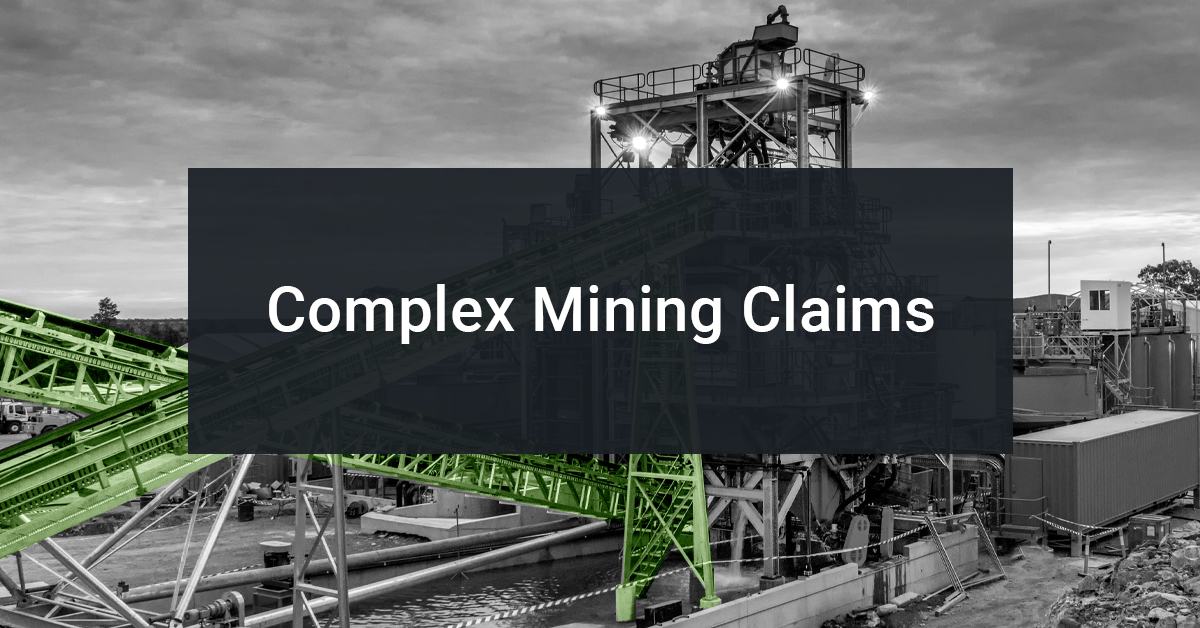As the global economy explores how to build resilience coming out of a pandemic, learning from the past can help position the mining industry for future success.
FROM PICKAXES TO PIXELS
For 42,000 years, humans have been digging in the dirt. What began as a simple search for rocks to sharpen has evolved into a sophisticated science that drives the modern economy. From oil to helium, access to natural resources – or a lack thereof – is arguably the biggest threat to global stability.
Modern mining operations depend on an intricate network of complex machines, human power, artificial intelligence, and geopolitical expertise. This can make managing the perils of mining (pre- and post-loss) a high-stakes business.
When a claim or large loss occurs, insurance professionals need experts they can depend upon to help manage the process.
MINING PERILS
Adjusters and Forensic Accountants are generally first-in after a loss event. But their work requires they understand the risks and perils associated with a complex mining operation before they arrive. Long hours of study and a deep knowledge of the mining business is essential to managing a complex claim, and the adjusters and forensic accountants selected to work on a complex mining claim must have additional hands-on field experience.
Modern mining sites can be on the surface, underground, and even underwater. Surface mining has 5 primary types: Strip, Open-Pit, Mountaintop Removal, Dredging, and Highwall. The risks associated with each type of activity are complex.
Most often, the site itself is a risk, especially from its exposure to natural elements like storms, floods, and earthquakes. Ground topography can also create threats to people and machinery. The machines are also a risk – they vary in type and size, from excavators and haulage trucks to conveyors and shipping containers. Anything involved in the removal and transport of raw material can suffer a loss.
Human capital is also a major risk, as skilled labor in many areas can be hard to contract, which can lead to safety issues and compliance violations. Add in long hours for everyone, inherent risk of injury, top-down investor and capital pressures, and the business of mining walks a fine line of risk/reward where any business interruption event has the potential to create catastrophic results (this includes fraud, workman’s comp, property casualty, and more).
ADJUSTING A COMPLEX MINING CLAIM
From mines like Antamina in the Andes – 12,OOO ft. above sea level – to the minus 47-degree Artic temperatures of Ekati where they search for diamonds, adjusters are tasked with understanding how the fire, explosion, flood, roof collapse, rock fall, or machinery breakdown occurred. Sometimes, this process can take several months.
The adjuster typically collaborates closely with qualified engineers and mine personnel to collect the facts. Without the facts, projecting the financial impact of a disaster is impossible. Modern adjusters regularly use technology like Augmented Reality, virtual dashboards, drones, and AI to more immediately and more accurately understand the scope of the loss and whether it was the result of man, machine, or natural peril.
In cases of white-collar crime like fraud, adjusters must also have an understanding of the mining business – how it is extracted, how it’s moved through ports, how its processed and sold, how it’s valued in the marketplace, and how the businesses operations will be impacted by the fraud.
QUANTIFYING MINING BUSINESS INTERRUPTION LOSS
Once the adjuster has filed their report, the forensic accountant will begin their investigation. To determine the financial impact, they’ll interview employees, business partners, dig through financials (paper and digital), and run calculations. Quantifying the loss requires an intimate understanding of the mine and its operational standards.
In some cases, the forensic accountant will also need to examine the equipment with an expert to determine if it was mechanical or user error. Right now, the mining industry is dealing with processing circuit issues related to Gearless SAG mills. As low-grade ore deposits are exploited, more rock has to be crushed and processed to achieve economic recovery. Single-stream crushers and Gearless SAG and Ball Mills have replaced traditional motor gearbox and girth gear drives.
While these Gearless mills have greater capacity, their long-term reliability has been questionable, and their failure has resulted in some very large losses. As these are bespoke machines and costly, complete spares are not held but spare electrical coils might be held by the mine. However, replacement requires a specialist, adding to the potential extra expense.
BACK TO THE FUTURE
Today, experts have identified several notable mineral deposits in third world countries. However, factors like infrastructure and geopolitics present the risk of protracted downtime. With every interruption being costly, insurance companies thinking about underwriting the operation can look to the past for answers.
In the event of a potential incident – whether due to remote access, available spares, and skilled workers – experienced adjusters and accountants written into a policy can advise both the insurance companies and mine operators about known perils, everything from personnel, site stability and security, to the benefits of properly maintained equipment, appropriate technology, and best practices in excavation, transport, and processing.
Additionally, adjusters and forensic accountants can provide insight and feedback on establishing Standard Operating Procedures, Business Continuity Plans, and appropriate cash and equipment reserves, items that could be considered requirements in future policies to make mining in these high-risk areas viable.
And while no plan can be 100% fool-proof, minimizing catastrophic mining losses is possible with proper planning and respect for what is known and unknown, making future mining endeavors more about the treasure in the mountain than the heaps of trouble on it.


